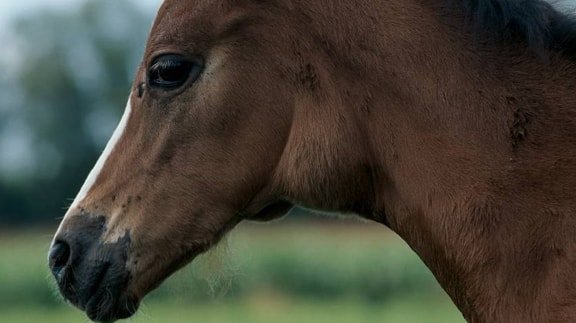Strangles in horses is acute, contagious bacterial diseases characterized by rhinitis, pharyngitis, and abscess in different lymph nodes. Strangles is mainly a disease of young horses. The disease occurs in horses, donkeys, and mules. The disease causes swelling of lymph nodes, obstruction of airways, compressing the trachea, larynx, and pharynx called “Strangles.”
Importance of Strangles in Horses
Strangles are the most acute disease in the equine population. The disease is enzootic in horses and is found worldwide. The disease mainly affects the young and unvaccinated foals, but the age group of horses is susceptible. In my article, I shall highlight the essential information on this critical disease of horses.

Causes of Equine Strangles
Strangles are caused by the gram-positive bacteria Streptococcus equi. The bacteria are also called Streptococcus equi subspecies equi.
Distribution of Strangles in Horses
Strangles is a relatively common equine disease with distribution worldwide. Young horses are most commonly affected, but all ages are vulnerable to the disease. The susceptibility of the disease depends on the immune status of the host.
Epidemiology of Strangles
The highly adaptive S equi is maintained only in the horse population in which clinical disease is occurring. Survival is brief in the environment unless the organism is protected in moist discharges. Horses and donkeys of all ages are susceptible to strangles, though strangles are most common in animals less than five years old, especially the group of weanling foals or yearlings. Foals less than four months of age are usually protected by colostrums-derived passive immunity.
S equi is maintained in the horse population by carrier horses but does not survive for more than 6-8 weeks in the environment. Although the organism is very robust, the infection is highly contagious. Pre-existing immunity may facilitate the expression of the disease. Morbidity in the age group may be up to 100%, with a 1-5% mortality rate. Older animals show lower morbidity and mortality.
How Does A Horse Get Strangles?
Strangles in horses is highly contagious and easily transmitted through bacteria found in discharges from infected animals. Coughing will include aerosol the bacteria through the nearest air stream. Transmission is either by direct contact with an infected animal or indirect contact by equipment with an affected horse. Direct contact with the animals includes:
- contact with an individual that is incubating strangles.
- An animal just recovered from an infection.
- With an animal long-term, carrier but did not show signs.
Indirect contact occurs when a susceptible animal comes in contact with a contaminated stable or pasture environment or flies.
Pathogenesis of Strangles in horses
Infection of pharyngeal and nasal mucosa causes acute pharyngitis and rhinitis. The incubation of strangles is 3-12 days. The infection spread through the lymph channel but generally remains localized in the tissues adjacent to the original point of infection. Metastatic infection may occur in any organ of the body. In the chronic form, a significant variation in localization is found. The infection may reach other organs, causing the development of the suppurative processes in the kidney, brain, liver, spleen, tendon deaths, and joints.

Clinical Signs of Equine Strangles
The disease’s incubation period is 3-12 days, and the complete course of the disease is 3-4 weeks with recovery. The usual clinical signs are:
- Fever up to 106 F, anorexia, and difficulty in swallowing.
- Extension of head and neck, and coughing.
- There is rhinitis and pharyngitis with later swelling and eventual abscessation of lymph nodes, particularly the intermandibular and parapharyngeal that drain upper respiratory and buccal mucosa.
- The swelling lead to suffocation with the need for emergency tracheotomy.
- There is profuse purulent nasal discharge.
- The abscessed lymph nodes rupture in 1-2 weeks and discharging a large amount of pus.
- Infrequently, abscesses of the parapharyngeal lymph nodes rupture and leading to infection of the guttural pouch and sinuses.
- Infected horses may be served as carriers of the disease.
Diagnosis of Equine Strangles
A preliminary diagnosis is usually made based on the characteristic clinical signs; however, laboratory confirmation is recommended.
- Horses suffering from S equi infection are at risk for developing complications.
- In severely affected individuals, upper airway endoscopy, thoracic ultrasonography, and thoracic/skull radiography may be indicated.
- Upper airways endoscopy is indicated for those individuals with severe nasal discharge. The evaluation will aid in identifying exudate and potential for chondroid, allowing for facilitates larvae when necessary.
- Identification of causal bacteria by culturing fresh pus from the infection site.
- PCR testing from nasal discharge or guttural pouch larvae sample.
Treatment of Strangles in Horses
The treatment procedures of strangles are as follows:
- Care and nursing of the affected horse.
- Keep the horse in complete rest.
- If required, apply fluid therapy intravenously.
- Treatment with an antimicrobial drug is controversial. High doses of penicillin, sulfonamides, or trimethoprim-sulfadiazine for 7-10 days are recommended for severe cases and nursing foals.
- Surgical drainage of the abscess produced in the throat region may be necessary.
- Tracheostomy may be necessary in severe cases.
- If the treatment started early, the development of abscesses could be prevented or reduced.
Prevention of Equine Strangles
The most practiced preventive measures of strangles are:
- Isolation and monitoring of horses to be added to a stable for 3-4 weeks.
- Vaccination is recommended for only high-risk individuals, e.g., introduction to a farm with endemic strangles. Vaccination appears to reduce disease severity.
- Intranasal vaccine: Horses not previously vaccinated against S equi subspecies equi should receive an initial series of two vaccine doses approximately four weeks apart. Annual boosters are recommended in high-risk individuals.
- M-Protein Vaccine: Adults should be vaccinated with an initial series of 3 vaccines at four-week intervals with booster vaccination at 10-12 months intervals.
- Foals considered at high risk should be vaccinated with an intranasal vaccine beginning at six months of age with an initial series of 3 vaccines administered monthly.
- Booster vaccine should be administered annually.